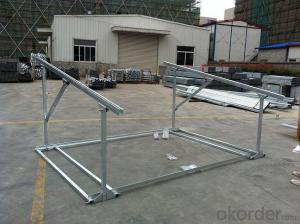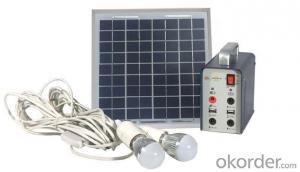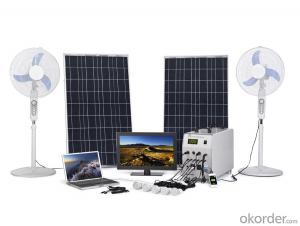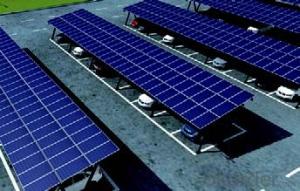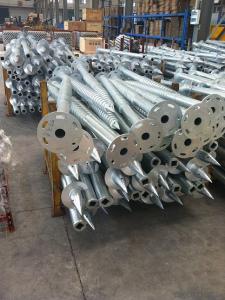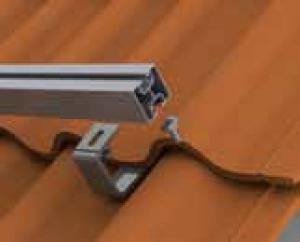Puerto Rico Solar Energy Systems Solar Mounting System Roof System
- Loading Port:
- China Main Port
- Payment Terms:
- TT OR LC
- Min Order Qty:
- -
- Supply Capability:
- -
OKorder Service Pledge
OKorder Financial Service
You Might Also Like
Packaging & Delivery
Packaging Detail:Normal package seaworthy
Delivery Detail:15 days
Specifications
Easy installation Competitive price TUV&SGS test report & CSA certification 15-warranty
Specifications
1) Super smooth beautiful appearance,outstanding quality,large supply.
2) Available in customized surface finishes.
3) Well machined,for example,cutting,drilling and milling with excellent tolerance.
4) Meet with customer’s designs and supply you best price.
5)Usages:Supply for solar panel modules.
Technical characteristics
Installation site:
ground,hillside,and grassland
Installation angle
it is based on customers’ requirements
Installation height
it is basedon customers’ requirements
Solar panel type; with or without frame
Components arrangement :horizontal or vertical
Support track
aluminum alloy extrusion
Quality warranty
15 years
Advantages
1)Quick installation: with high degree of pre-installed rate, the system could be easily installed by using galvanized carbon steel rails for PV Stent, and specially designed connection parts of the PV bracket, which could reduce installation time and cost greatly.
2)Offer unmatched durability: with all structural components comprised of high class stainless steel and anodized aluminum alloy, it is designed for 25 years service life and backed by 15 years warranty.
3)Stand up to extreme weather: The SuninTek solar mount is designed to stand up to the extreme weather complied with the AS/NZ 1170 and other international structure load standard by the skilled engineer. The main support components also have been tested to guarantee its structure and load-carrying capacity.
4)Provide broad installation flexibility: These systems accommodate most commercially available framed solar panels , and they can scale easily from small to large, multi-megawatt installations.
5)Diversified Application: The PV mounting system produced can be adopted by various types of PV cells panels which you can find in the market. It can serve for both mini solar power system and huge plant with megawatt capability.
Main features
1. Installation cost savings.
2. Save installation time.
3. Increase the mechanical strength of solar energy mounting to ensure that wind requirements.
4. The outdoor for installation of solar energy.
5. Length can be customized according to customers.
6. Service life of up to 25 years.
7. Products through the international certification.
8. Stent material composition of the galvanized steel and aluminum.
9. 15 years system and structural guarantee.
10.Flexible post spacing withstands different wind & snow loads.
11. High quality material in Aluminium 6005-T5 and SUS 304.
12.Screws and nuts go with every components needed.
13.Mechanical calculation and reliability tested to ensure highest product quality.
- Q: Can solar energy systems be used in areas with high levels of air pollution from industrial activities?
- Yes, solar energy systems can be used in areas with high levels of air pollution from industrial activities. Solar panels primarily rely on sunlight to generate electricity, and even in areas with polluted air, sunlight can still reach the panels. While air pollution may reduce the efficiency of solar panels to some extent, they can still produce electricity and provide a clean energy alternative to offset the environmental impact of industrial activities. Additionally, using solar energy can help reduce the reliance on fossil fuels, contributing to the overall reduction of air pollution in such areas.
- Q: How do solar energy systems impact roof maintenance and repairs?
- Solar energy systems can have both positive and negative impacts on roof maintenance and repairs. On the positive side, solar panels can provide an added layer of protection to the roof surface, shielding it from harsh weather conditions and UV radiation. This can help extend the lifespan of the roof, reducing the need for frequent repairs or replacements. Additionally, solar panels can prevent debris from accumulating on the roof, reducing the risk of damage caused by fallen leaves, branches, or other objects. However, there are also some considerations when it comes to roof maintenance and repairs with solar energy systems. Installing solar panels generally requires drilling holes into the roof to secure the mounting brackets, which can potentially lead to leaks if not properly sealed. Therefore, it is crucial to work with experienced and qualified installers who understand the importance of proper sealing and waterproofing. Another factor to consider is access to the roof. Solar panels cover a significant portion of the roof surface, making it more difficult to access and inspect the roof. Regular roof maintenance tasks, such as cleaning gutters, removing debris, or inspecting for damage, may require additional effort and specialized equipment when solar panels are present. In terms of repairs, solar panels can complicate the process. If a repair is required on the roof, the solar panels may need to be temporarily removed to access the damaged area. This can add time and cost to the repair process. Additionally, it is important to coordinate with the solar panel manufacturer or installer to ensure that any repairs are done in a way that does not void the warranty or affect the performance of the solar system. In summary, solar energy systems can have a positive impact on roof maintenance by providing added protection and reducing the risk of damage. However, it is important to work with experienced installers, ensure proper sealing, and consider the impact on access and repairs when installing solar panels.
- Q: Do solar energy systems require batteries for energy storage?
- Batteries are not always required for energy storage in solar energy systems. While they can store extra energy generated by solar panels for later use, they are not essential. In grid-connected solar systems, excess energy can be sent back to the utility grid, allowing homeowners to draw power from the grid when their panels are not producing enough. This eliminates the need for batteries as the grid acts as a virtual storage system. However, for off-grid systems or areas with unreliable grid access, batteries are commonly used to store excess energy. Ultimately, whether or not batteries are used in a solar energy system depends on the specific circumstances and requirements of the installation.
- Q: Can solar energy systems be used for desalination of water?
- Yes, solar energy systems can be used for the desalination of water. Solar-powered desalination systems harness the energy from the sun to power the desalination process, which removes salt and impurities from seawater or brackish water, making it suitable for various applications such as drinking, irrigation, or industrial use. These systems typically utilize solar panels to generate electricity, which then powers the desalination equipment, such as reverse osmosis membranes or solar stills, to separate freshwater from saltwater. This sustainable and renewable approach offers a promising solution for addressing water scarcity issues in regions with ample sunlight and limited freshwater resources.
- Q: How do solar energy systems affect air pollution?
- Solar energy systems have a positive impact on air pollution as they generate electricity without emitting any harmful greenhouse gases or pollutants. By replacing traditional fossil fuel sources, solar energy helps to reduce air pollution, improve air quality, and mitigate climate change.
- Q: Can solar energy systems be used to power an entire home?
- Yes, solar energy systems can be used to power an entire home. By installing enough solar panels and a battery storage system, a home can generate and store enough electricity from the sun to meet its energy needs throughout the day and night.
- Q: Can solar energy systems be used for powering outdoor signage or billboards?
- Yes, solar energy systems can indeed be used to power outdoor signage or billboards. Solar panels can be installed on the rooftops, nearby poles, or on the billboard structure itself to harness sunlight and convert it into electricity. This renewable energy source provides a sustainable and cost-effective solution for powering outdoor advertising, reducing reliance on traditional grid electricity and minimizing environmental impact.
- Q: Can solar energy systems power an entire home or business?
- Yes, solar energy systems can indeed power an entire home or business. With advancements in technology and the availability of efficient solar panels, it is possible to generate enough electricity from solar energy to meet the energy demands of a building. Additionally, when combined with energy storage solutions like batteries, solar energy can provide uninterrupted power even during non-sunny periods.
- Q: Are there any advancements in solar energy system technology?
- Yes, there have been significant advancements in solar energy system technology. These include improvements in solar panel efficiency, the development of new materials for panels, the integration of storage solutions for better energy management, and advancements in solar tracking systems. Additionally, there have been innovations in solar energy system design, such as the use of floating solar farms and the integration of solar technology into building materials. These advancements are making solar energy more accessible, affordable, and efficient, contributing to its increasing adoption worldwide.
- Q: Can solar energy systems be used in military applications?
- Yes, solar energy systems can be used in military applications. Solar technology has proven to be highly adaptable and reliable, making it an attractive option for military operations. The military has recognized the benefits of solar energy systems in terms of reducing dependence on fossil fuels and improving energy security in remote or volatile regions. One of the key advantages of solar energy systems in military applications is their portability. Solar panels and related equipment can be easily transported and deployed in various locations, providing power for small-scale operations or even entire bases. This flexibility allows military units to operate in off-grid or austere environments where traditional energy sources may be scarce or unreliable. Solar energy systems can also enhance the sustainability and resilience of military operations. By generating renewable energy on-site, the military can reduce its carbon footprint and decrease reliance on vulnerable supply chains for fuel. Solar power can be integrated with energy storage solutions to ensure continuous power supply, even during grid outages or in combat situations. Furthermore, solar energy systems contribute to cost savings in the long run. While the initial investment may be higher compared to conventional energy sources, solar technology has become increasingly affordable. Over time, the operational and maintenance costs of solar systems are significantly lower than those of conventional energy sources. This can result in substantial savings for the military, allowing resources to be allocated to other critical areas. In addition to these benefits, solar energy systems also offer enhanced tactical advantages. Solar-powered equipment and devices can operate silently, reducing the risk of detection by enemy forces. Furthermore, solar energy systems can reduce the logistical burden of transporting and storing traditional energy sources, allowing military units to be more agile and efficient in their operations. Overall, solar energy systems offer numerous advantages for military applications. The technology's versatility, portability, sustainability, cost-effectiveness, and tactical benefits make it a valuable asset in enhancing military capabilities while reducing environmental impact and improving energy security.
Send your message to us
Puerto Rico Solar Energy Systems Solar Mounting System Roof System
- Loading Port:
- China Main Port
- Payment Terms:
- TT OR LC
- Min Order Qty:
- -
- Supply Capability:
- -
OKorder Service Pledge
OKorder Financial Service
Similar products
Hot products
Hot Searches
Related keywords
